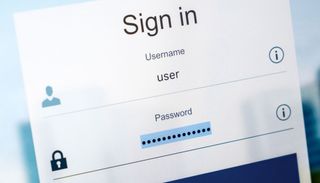5 essential tips for protecting your online passwords
5 essential tips for protecting your online passwords

You've heard the advice — likely many times over — that you should create strong, unique passwords for all your online accounts. However a significant number of people are still using "12345," "password," and "qwerty" for their emails, depository financial institution logins and east-commerce accounts.
There are plenty of issues with this approach to digital security, one of which is the risk of your personal data being accessed in a credential-stuffing attack. Credential stuffing is a type of brute-strength hack in which cybercriminals accept login data stolen in past data breaches and use it to systematically attempt to break into other accounts.
- How to create and remember super-secure passwords
- The best countersign managers to keep your logins direct
- Why you should never reuse a password
Data shows that there are 3.6 meg credential-stuffing attacks every hour in the U.S. While the success rate is extremely low, the sheer volume of attempts means that plenty of personal information is compromised. Plus, unlike traditional brute-force attacks that rely on random guesses, credential stuffing takes advantage of the fact that people reuse passwords that have already been stolen.
And then what can you do to protect your passwords?
Utilise unique passwords
Seriously. More than than fourscore% of people use a single password across multiple websites, just reusing your passwords puts yous at higher take chances for falling victim to credential stuffing. That compromises your personal data and increases the likelihood of experiencing financial losses and identity theft.
"Human nature is to make things easy for ourselves," said Steve Tcherchian, chief information security officer at California data-security firm XYPRO. "Nosotros don't similar to be inconvenienced. We similar fast, nosotros like quick. Therefore, most users use the same or similar username/password combination for nearly all access to websites."
Another fashion to mix upwardly your username and password combos is to use multiple email addresses instead of relying on the aforementioned electronic mail for every single login. But y'all don't take to set upwardly multiple electronic mail accounts to do this.
Gmail and Microsoft Office 365 let you lot employ "plus" email addresses for this purpose. And then John Smith can sign up for Amazon with "john.smith+amazon@gmail.com" and sign up for Facebook with "john.smith+facebook@gmail.com", but letters sent to each address will land in the inbox of john.smith@gmail.com.
Make your passwords stronger
While yous're creating unique credentials for each business relationship, make sure your passwords aren't piece of cake to crack. The most secure passwords are long and complex, which makes them more hard to guess. Easy-to-call back passwords, in contrast, are extremely weak — even if they're unique.
Here are a few ways to brand your passwords more than secure:
- Make each password at least 15 characters long.
- Use lower-example and upper-case letters also as digits and punctuation marks.
- Avoid real words and any parts of your proper noun or electronic mail address.
- Don't use any information that can be plant on social media, such as your birthdate or pet's name.
Utilize a countersign manager
If you lot're relying on your own memory to keep rails of many long and circuitous logins, of form you lot're more probable to default to a few brusque and unproblematic passwords. Fortunately, there'due south a solution.
The best password managers tin generate strong, unique passwords for new accounts, call up your passwords for you, and tell you when you're reusing credentials or if your information was compromised in a data breach.
Password managers also sync across multiple devices, such as PCs, Macs and smartphones. All you lot accept to do is remember the main password (or enable biometrics such equally Confront ID).
This is more than secure than having your browser remember passwords. For example, on a Mac where Chrome uses your Apple keychain, a cybercriminal could get access to everything once they have your Gmail password.
Enable multi-gene authentication
Multi-cistron hallmark (MFA) adds a layer of security past requiring you to verify your identity with something besides a password when you log into an account on a new device or from a new location. Without this secondary key, a hacker won't be able to become in even if they accept your password. Enable MFA or 2FA whenever information technology's an option.
As Pieter VanIperen, security expert and founder of PWV Consultants in New York, explains, these keys can block credential stuffing "considering your password only gets them to the adjacent door even if they have purchased information technology and aren't stuck guessing."
Common 2nd factors of authentication involve temporary passcodes sent to your phone via text or app. While this may seem secure — and it may exist better than zippo — information technology'due south not that difficult for criminals to intercept SMS or transfer your phone number to their ain SIM card.
Better options include authenticator apps (Google Authenticator works with most major services) or physical security keys like the YubiKey or the Google Titan.
Heads up: If yous're getting notifications to authenticate accounts you're not actively logging into, that'south a expert indication that someone else is trying to access your data.
Monitor public data breaches
Proceed an eye on security news then y'all know when your information may be compromised. So enter your email into https://haveibeenpwned.com/ to notice out if your data has been exposed in a public data breach.
Lesser line
You may non be able to avoid data breaches and credential stuffing completely, but you can minimize the likelihood that cybercriminals will be successful in hacking their way into your accounts.
Source: https://www.tomsguide.com/how-to/protect-online-passwords
Posted by: wilsonters1972.blogspot.com


0 Response to "5 essential tips for protecting your online passwords"
Post a Comment